Up On The Roof: An Urban Farm Right Above The New York Produce Show And Conference
December 8, 2021 | 18 min to read
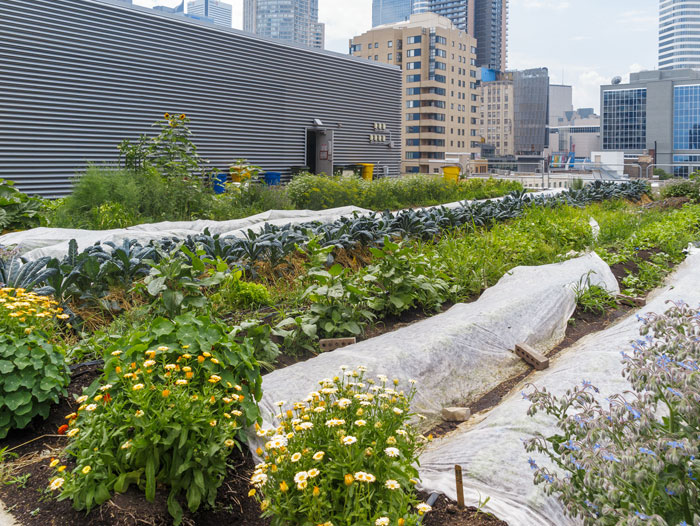
The world is a funny place. Who would have thought that in doing a trade show and conference in Manhattan, probably the most urbanized place in America, that we would be closer to pear trees and carrots growing than any produce event in the United States, maybe the world! How did this come about? Well because the Javits Center, where we hold the New York Produce Show and Conference just did an expansion and included a rooftop farm, greenhouse and orchard!
Coincidentally, it is like old home week for us as the program intersects intensely with one run by Brooklyn Grange, which happens to be where we did the first first tour of the first edition of The New York Produce Show and Conference.
In any case, it is exciting that the produce industry is interacting in this most urban of settings. We asked Pundit Investigator and special Projects Editor, Mira Slott, to pay a visit to the Javits Center rooftop:
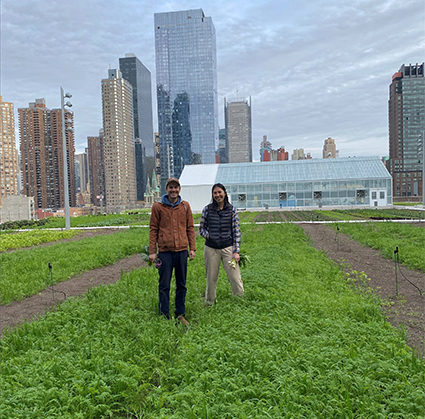
Ben Flanner, CEO of Brooklyn Grange and
Jacqueline Tran, Energy & Sustainability Manager
at the Javits Center team up for a tour of the
Farm with Mira Slott of PB.
Q: Jacqueline, I’m so excited to meet you and reunite with Ben Flanner [CEO of Brooklyn Grange] for this breathtaking onsite visit, and to learn more about your inventive Javits rooftop farm, greenhouse and orchard. It’s quite an experience to discover sprawling rows of fresh vegetables growing wholesomely across the Javits roof, amid the sky-high expanse of the Manhattan landscape…
As we run the New York Produce Show & Conference at Javits, focused on fruits, vegetables and plants/flowers ensconced in issues of sustainability and innovation, we are thrilled to highlight both the Javits expansion and the new “green approach,” and what’s ahead in your unfolding venture. The New York Produce Show couldn’t be a more perfect platform!
A: I agree. It’s great that we could coordinate the timing with our Brooklyn Grange partners to do the tour all together, and still catch the Farm in optimal condition for fall’s seasonal vegetable varieties.
[Editor’s note: Indeed, there were many seasonal vegetable varieties to explore on this brisk, windy, 50-degree day on November 3, with sun peeking through the clouds, along with carrots, turnips and a bevy of herbs and leafy greens curiously peeking through the rooftop, readying to harvest for Javits Center events, including the New York Produce Show!]
Q: We have featured Brooklyn Grange at previous New York Produce Shows, and attendees have had the opportunity to tour the company’s original rooftop farm in Long Island City, and the Brooklyn Navy Yard Roof Top Farm and Apiary. I still have fond memories of my visit to the first Brooklyn Grange rooftop farm in Queens for a piece for our inaugural New York Produce Show in 2010, when both were burgeoning concepts. Much has transpired since, as we look to showcase this latest milestone at the Javits Center.
Editor’s Note: As we wait for Ben Flanner to arrive, and Produce Business magazine’s videographer scopes out the scene for our dynamic tour, Jacqueline and I have a chance to chat.
Q: For perspective, I’m hoping you can talk about the evolution of the Farm, how it came to be, how does it fit with the $1.5 billion investment in the Javits expansion and sustainability goals and the overall vision?
But first, tell us a little about yourself, your responsibilities and role.
A: Okay. So, I’m the Energy and Sustainability Manager at the Javits Center. I oversee the sustainability, climate, and resiliency program for the facility. And really, just kind of pushing our goals for New York State in terms of being a state entity. Our goals in partnering with our customers and our general contractors on their sustainability initiatives and hoping to realize ours as well.
Q: What do those sustainability initiatives encompass?
A: Really, we’re looking at all facets of sustainability. It is a multifaceted kind of sector, so looking at energy, waste, water, food, and beverage, all the different topics that really allow for 100 percent true sustainability. And our mission is to be a model for sustainability.
Q: Oh, that’s an interesting prospect, that you’re developing a model for others to replicate.
A: Yes. So, a model for sustainability in terms of the events industry and what venues can do and what sustainability can do for their community as well.
Q: How did you become partnered with Brooklyn Grange in development of the Farm?
A: I’d like to start at the beginning because it really stemmed from our green roof on the Javits South building. That renovation finished in 2014. We put a 6.75-acre green roof on that building. And from that green roof, we started to study the effects. We saw the benefits of green roofs on the community in terms of mitigating storm water runoff, looking at how it reduced the temperature of our building and the surrounding area.
That’s helping with the urban heat island effect…and we started seeing the building become a wildlife sanctuary. We studied the different species of birds and bats and bees that really utilized our roof. And then we thought, look at all the wonderful things that come from putting this living roof on a building. What else can we do?
So, when we had the opportunity to do a design and development of the expansion, led by Lendlease Turner, which was a joint venture of two construction companies, with TVS Design the architect of record.
We thought okay, we can put a green roof on, but we can do one better. We can actually make it the type of green roof that turns into a farm, where we can grow food and then that food can be harvested and put into our catering and be part of our food and beverage program.
Q: That really takes things to another level…
A: We started looking in the market for organizations that could really partner and blend into our sustainability story…We put out an RFP and Brooklyn Grange bid on it, and we instantly saw that the values were aligned.
Q: That triggers many questions. I understand the plan is to grow up to 40,000 pounds of produce annually. Could you elaborate on how this produce will be utilized at the Javits Center? Is this exclusively for catered events through the Javits Cultivated kitchen, will it be available at the restaurants, food court within the Javits Center. Are you also looking to sell or donate produce that’s grown here?
Will the quantities, types of varieties be sufficient, or more supplementally focused on unique flavor profiles/qualities? Will the Farm be profitable, and/or more of a great ‘hyper-local’ marketing opportunity, to create consumer awareness of sustainability issues, etc.?
A: Great questions. I can cover them all. So, it’s a one-acre farm, it’s the largest rooftop farm in Manhattan, and it’s correct that we estimate about 40,000 pounds of produce to be grown annually. All that produce is destined for our catering, and we’re kind of looking at how we can provide farm to table experiences for our events.
But sometimes there is excess and sometimes you need to allow avenues for things not to go to waste. So, we do have robust food rescue through local organizations like Rethink Food, City Harvest, New York Common Pantry are just a few of them. And if needed, we can continue our food rescue program of these farm fresh items to the food insecure and those who need it.
Q: Some of the more technical production questions might be good to ask Ben as we do our tour, but I know that you’ve been working with Jessica Brooks, Program Manager, NYS Grown & Certified, at the New York State Department of Agriculture & Markets, on expediting GAP and the environmental management review for certification.
A: Yes, we just got it.… the New York State Department of Agriculture & Markets has certifications for things that we want to align with, regarding sustainability, and making sure that our methodologies and how we operate are conserving water, conserving soil, organic-like procedures…
Good Agricultural Practices (GAP) certification really looks at all those aspects but also from a food safety standpoint, which is critical, looking at how we are growing food, harvesting food, storing food, temperature’s really important, how that’s moving into the kitchen…and then once it’s handed off in the kitchen, that’s when the chefs are using their standard operating procedures that are now in the jurisdiction of the health standards. Those standards are already in place, so now on the farm side, we’re guaranteed.
Q: Continuing our discussion about the optimal production and uses of the produce, this will come from the one-acre farm, and also the greenhouse to accommodate the seasonal limitations, as well as the 10,000 square-foot fruit orchard?
A: Sure. We’re estimating those 40,000 pounds are for the entire area of the farm and greenhouse, and the apples from the orchard. We’re measuring that. We just started planting mid-September, so we’re learning every day.
Q: Of course, it’s so early in the process.
[Editor’s note: Ben Flanner later shares news about the Orchard, which houses 32 apple trees and six pear trees. “This is a very exciting part of the project. This has potential to become an interesting habitat. We’ve added clover and inoculated winecap mushrooms into some of the mulches surrounding the trees, which hopefully will take root. And we’re installing other fruit crops between the trees, blueberries and currants to create a kind of food forest, and perennials flowering all year long in the Pavillion for the birds and bees. I’m not sure what the yields will be but as the trees grow, the yields will get larger and larger. I think we could easily do a couple thousand apples next year in the spring,” he says, noting that apples are a big part of the New York State economy, which connects well with the project].
A: We’re really looking at the whole operation, to start tracking and learning and understanding our ebbs and flows. I think once we go through a full season with a full year of events and we see what that looks like, we’ll be able to know more. But the one-acre farm itself is more like a three-season farm. The fourth season goes into the greenhouse, where we have some product units that will allow us to continue production of greens and various other crops that we can grow hydroponically, depending on what the needs are from the events and what the chefs think will be really useful to supplement their menus.
Q: That would be interesting to hear more about. What are the ideal types of produce items that would grow on the Farm? Are you experimenting with different varieties, unique opportunities? I remember when I visited the first Brooklyn Grange rooftop farm on an industrial building in Queens back in 2010, co-founder Anastasia Cole was surprised to discover that through innovative technologies and farming methods, they could grow a range of varieties, and specialty items, and overcome challenges that come with producing produce in an urban rooftop farm setting… For instance, she was excited to show me an unusual Italian Cucuzza squash that grows extra-long, and a purple tomatillo that tasted like a plum. Anastasia says Ben’s prescience back then was impressive with the sophisticated advances that have taken place in rooftop farming since, as you now explore different sustainability initiatives in the greenhouse here for a fully integrated system.
A: So, that’s the really great part about Brooklyn Grange. We’re able to deliver some specialty produce items that maybe are not as readily available in the market. And we’re able to kind of specialize specifically into those crops that may get the biggest feature in the menus for farm to table.
It will really depend on the feedback from our customers and from the chefs as well if there’s the ability to really maximize the yield on these things, while you’re selling it the customer for whatever experience that they want. That’s where the big learnings will come from.
Q: Right. Yields would be a consideration… This also could be used as an experimental, pilot-like program to test new directions.
A: That’s true.
Q: The Javits Farm has received nice consumer media attention on local T.V. stations, as well as some national coverage, understandably targeted towards the general public rather than the produce industry. What do you think will be most interesting for New York Produce Show attendees to know?
A: That’s a great question. Hmmm. Thinking about your diverse audience across the supply chain, I’d say, how we’re approaching what produce we’re growing. We’re working primarily with chefs. It’s the things that bear wanting to go above and beyond on quality and taste, maybe it’s identifying the carrots they want, perhaps it’s the baby carrots, but freshly picked baby rainbow carrots…
It’s a different kind of thinking and getting that goal into the farmers’ mind. And so a couple examples. The chefs really like Shiso leaf.
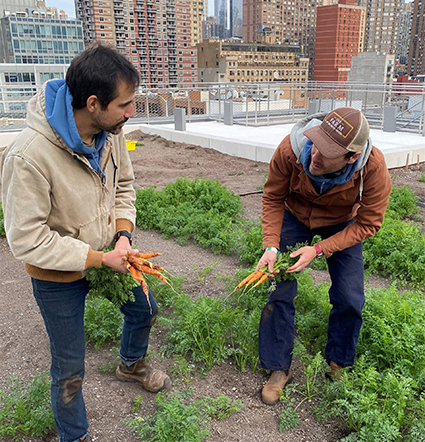
Orion Ashmore, Farm Manager at Javits joins
Ben to harvest carrots.
A: Marc Tourtollet, our executive chef at Cultivated, tried Shiso and got excited about the flavor. It’s a great kind of wide leaf with really beautiful variegation in it, colors, and you can use it to wrap things with and you can use it as an herb as well. He really identified with that taste and just immediately, the creativity was going into the menus for what he could do with red and green Shiso leaves.
So, we started planting that and he’s finding new avenues for it. He’s liking that.
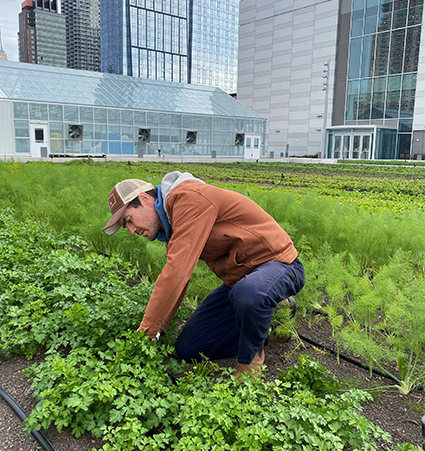
Ben farming the seasonal herbs, explaining the
popularity of a parsley variety…
Q: Great example.
A: Brooklyn Grange also has experience in doing this outside of the Javits Center. That’s why we hired them. They’ve already looked at other varieties of things like these Hakurei turnips.
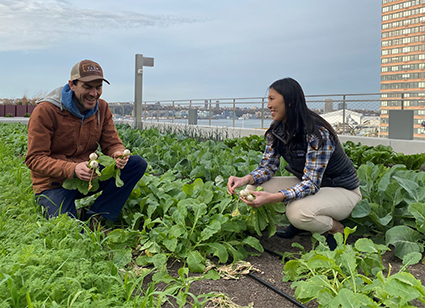
Ben and Jacqueline harvesting Hakurei turnips together
Q: I’ve never heard of the Hakurei turnip…
A: Brooklyn Grange found it was easier in terms of an advantage for the production in some fashion, as well as the speed in the growth, and the taste. They’re also selecting for those advantages in how they’re farming, and also meeting the demands from chefs.
Q: Very interesting. It can be so customized and specialized, and you can work on developing different products that might not be as viable to mass market.
A: Yes. Exactly. That’s where we’re going as the Javits Center, kind of hosting and utilizing our vendors to really improve the communication between the two and allowing them to start customizing menus based on the calendar, based on the growing season, and all the conservation initiatives that go around a regenerative agricultural method as well.
Q: Okay, to confirm, this is all on the foodservice side. You’re not doing anything with retailers…
A: That’s right. I think it can inspire what could be done in retail, although I believe our Chef did put some of the Farm’s mixed greens into the Amazon Fresh and Fast, which is technically a retailer. He packaged product in clamshell-type containers for customers at Amazon Fresh and Fast. We had a lot, and we do want to try to keep it in house before donating. Of course, we will, but if we can keep it in house allows that story to blossom.
Q: Isn’t Amazon’s Fresh and Fast a recent addition, as part of the Javits Center expansion? It’s making some waves as a novel retail concept…
A: Yes, Amazon Fresh and Fast opened at the Javits in August, and is in the Javits concourse on the North side.
Q: New York Produce Show attendees may be curious to check it out…
A: We’re big on our community so we do have plans to expand our current tour program that has been on pause because of the pandemic. But we’re looking forward to next year and expanding our tour program to include the Farm, to include all our sustainability initiatives…and to get the community thinking about the food system more. I think everybody at the New York Produce Show would agree that consumers are disconnected from their food and where it comes from. I think it allows us to really show that to our community, why it’s important.
Q: In some ways, this extended community interface connects back to the integral role Javits played to help people during the pandemic, from transforming into a hospital for COVID patients, to becoming a central vaccination location…and opening again as a vibrant event space to bring communities together, ultimately from B2B to consumers.
The produce industry also has many initiatives to connect with consumers, yet it’s a constant struggle to increase produce consumption for numerous reasons. At the same time, there’s an obesity epidemic, food insecurity, as well as food waste. These problems are complex, and involve multi-faceted solutions…
A: I think it goes back to our mission, right? We can’t do everything, but we can put in examples that model what can be done and what’s possible.
Now we’re modeling our food system at the Javits Center. We’re able to look on a small scale about all the things that go into our food system. Where does the food come from? How is it grown? How are we utilizing our soil efficiently? How are we conserving water? How does this play into the biodiversity? Who are we feeding? And if there’s excess, what do we do with the excess in a way that’s sustainable? And it talks about access, too. So, everything that we’re doing is another piece of that story…
Q: I know this is going outside of the topic for today to converse about the future of different local farming methods, including rooftop farms, greenhouses, and vertical farming… These are very different types of growing options. Do you find that one is preferable over the other or is it more that they work in tandem? Could you talk about the cost and benefits of the rooftop farm? Is it cost effective from a business standpoint and from a profitability standpoint? For instance, does it involve a big initial investment and a certain time frame to reap the rewards…
A: I’d like to pass that one on to Ben. They are in the business of rooftop farming, and he can speak more to that. The goal of our farm is not to be a really profitable farm and look at the margin and all of that. For us, it’s really about the educational component, showing what’s possible at a convention center in the middle of Manhattan. It’s part of our mission to be a model. And it’s there to inspire other people to see what they can do. But I know that Brooklyn Grange has a successful business around this, and he can speak more to that.
Q: Yes, I can attest to that. Could you provide a little more information about the orchard and the greenhouse? The greenhouse also is new and in development, right?
A: It is. It’s going to be operational all year and will be really, really, useful in the winter, because it’s climate controlled. You have a lot of the technology in there that’s going to allow you to do some indoor vertical farming too. Half of it will be dedicated to the hydroponic system, which is basically a soilless method of growing food, where you can have some kind of substrate to grow herbs or greens or what have you. And then you’re using your reservoirs to essentially pump nutrients and water around to grow these things. Going back to your vertical farming point, we are trying to utilize a little bit of the vertical space to improve the yield. So our hydroponic system is actually two tiers.
Q: Oh, that’s interesting. You’ve got a system in place that also allows you to pilot new concepts as part of the model you’re building…
A: Yes, exactly. We really are trying to be leaders in that because we know where we are today in terms of the status of how climate change is already affecting our food system and changing the way we see the growing season. Things are flowering earlier. Then a frost hits and then you’ve lost all your peaches…
We’re trying to show all the things that maybe can be done to help out with that, and also raising awareness to some of these issues that we face.
Q: Leaders in the produce industry are going to be reading this and coming together at the Show. Is there anything they can do to partner or help you in your endeavors?
A: Yes. That’s a good question. I think the entire produce industry comes from so many different walks of life and they have such a wealth of knowledge that it would be amazing if we could all partner a little bit more. I think that’s the really great thing about the New York Produce Show. It’s bringing in all those leaders, all those minds and everybody talks a little bit about where they come from and what they know. I think together we can bring more awareness to the issues that we see with regards to climate change and other factors that are affecting the produce industry. And how consumers are so disconnected from the food system and are really suffering. We can bring these things back into the forefront and have a revolution around our food.
Q: Perfect. Thanks for providing insights into this exciting venture. I can’t wait to start our tour, so you and Ben can point out some of the intriguing things we talked about here, and maybe get a taste of a Hukarei turnip?
A: Of course. Harvested fresh on the spot for you! And we’ll be harvesting more root vegetables from the Farm for New York Produce Show attendees…
******
We hope you will join us in this very special facility!
You can register for the show right here.
Let us know if you would like a hotel room in the Headquarters Hilton Hotel by emailing us here.
Check out the show website right here.
And join us in the center right below a rooftop farm in the City of New York!
